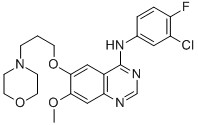

Gefitinib 184475-35-2 Peptides Steroids AKOS 91371 Cell Lung Cancer Treatment
| Indications and Uses | Gefitinib is an antineoplastic target therapy drug with relatively high specificity that was developed by the British pharmaceutical company AstraZeneca; it is the first molecular targeted drug to be used in non-small cell lung cancer treatment. Epidermal growth factors (EGF) are a kind of polypeptide with a relative molecular mass of 6.45x103, and they can bind with epidermal growth factor receptors (EGFR) on target cell membrane surfaces to trigger biological effects. EGFR is a type of tyrosine kinase (TK) type receptor, so when bound with EGF, it will promote TK activation in the receptor. This will cause tyrosine residue in the receptor to autophosphorylate and send continuous dividing signals into the cell, causing cell proliferation and differentiation. EGFR is abundant in human tissue, and it is highly expressed in malign tumors. Gefitinib blocks the signal transduction pathway of cell surface EGFR to prevent tumor growth, metastasis, and growth in blood vessels, and it can induce tumor cell apoptosis. Gefitinib is mainly used to treat non-stem cell lung cancer. |
| Pharmacokinetics | It is orally effective, with relatively slow absorption and metabolism following intake. The bioavailability of a single oral 250mg dose is nearly 60%, and its area under curve (AUC) is dependent on dosage. With single daily dosages, blood concentration is steady after 7-10 days, with blood concentration peaking 3-7 hours after medication and then gradually following biphasic reduction (its half-life is 12-58 hours, at an average of 28 hours). It is observed as dose-dependent pharmacokinetics, and following multiple dosages, AUC and Cmax increased proportionally. When taken with food, its Cmax and AUC did not decrease significantly. Its plasma protein binding rate is nearly 90%. Gefitinib is metabolized through many different pathways in the livers in a relatively complicated process; the main component of its oxidative metabolism is the cytochrome P450 enzyme CYP3A4, which mainly metabolizes O-Desmethyl metabolites. Metabolites are unrelated to the pharmacological effects of the original drug. The original drug and many metabolites are mostly passed through the biliary tract and excreted through feces, while the amount of drug excreted through urine is less than 4% the original dosage amount. |
| Adverse Reactions | Gefitinib is relatively well-tolerated, and most negative reactions are mild and reversible, characteristics that are vastly different from those of standard negative reactions to cytotoxic drugs. Common negative reactions include diarrhea, nausea, rashes, acne, vomiting, and feebleness. Only 1% of patients have had to cease treatment due to negative reactions with an occurrence rate over 20%. There have also been rare cases of acute interstitial pneumonia. |
| Warnings and precautions | Gefitinib is not suitable for personal |
| Chemical Properties | Light-Yellow Crystalline Powder |
| Uses | for research |
| Uses | Gefitinib is an antineoplastic. |
| Indications | The EGFR or ErbB1 inhibitor gefitinib (Iressa(R), AstraZeneca) was originally approved by the US FDA in 2003 under accelerated regulations for the treatment of locally advanced or metastatic non-small cell lung cancer (NSCLC) after progression on docetaxel- and platinum-based chemotherapy. AstraZeneca voluntarily withdrew gefitinib from the market in 2005, owing to failed verification of clinical benefit during post-approval studies. In July 2015, FDA reinstated the approval of gefitinib for a different group of patients (i.e., NSCLC patients with EGFR mutations). Other approved kinase inhibitors targeting the ErbB family, which includes ErbB1/EGFR, ErbB2/human epidermal growth factor receptor 2 (Her2), ErbB3/ Her3, and ErbB4/Her4, are erlotinib (Tarceva(R), OSI Pharm.), lapatinib (Tykerb(R), GlaxoSmithKline), vandetanib (Caprelsa(R), AstraZeneca), afatinib (Gilotrif(R), Boehringer Ingelheim) , and osimertinib (Tagrisso(R), AstraZeneca). All approved EGFR family inhibitors share a common quinazoline scaffold with the exception of osimertinib, which has a pyrimidinylphenylamine scaffold that resembles that of imatinib and nilotinib. Gefitinib and vandetanib adopt the type I binding mode with “DFG-in” and αC-helix “in” conformation, while erlotinib and lapatinib bind to“DFG-in”with the αC-helix adopting an “out” conformation. Afatinib and osimertinib are covalent inhibitors with an electrophilic enone moiety. |
| Brand name | 3M |
| Biological Activity | Orally active, selective inhibitor of EGFR tyrosine kinase (IC 50 = 23-79 nM). Shows minimal activity against ErbB2, KDR, c-flt, PKC, MEK and ERK-2. Blocks EGFR autophosphorylation and inhibits tumor growth in mice bearing a range of human xenografts. |